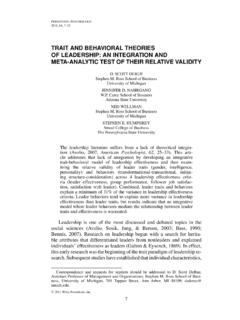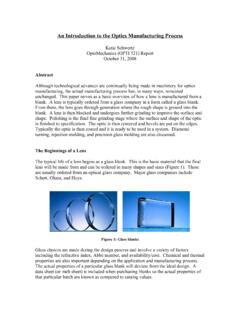Transcription of Polypropylene - Pennsylvania State University
1 Polypropylene Jared Spaniol Jack Rulander Mike Leo Introduction Spain, 1954, Polypropylene was first produced by Professor Giulio Natta. Natta was able to produce the resin by using catalysts from the polyethylene industry and applying them to propylene gas. The first commercial production began in 1957. Polypropylene is a very versatile material. It offers a great combination of properties such as lightweight, strong, high heat resistance, as well as stiffness and flexural retention. Among these and many other great properties, Polypropylene is easily fabricated. Polypropylene can be subjected to a wide range of fabrication methods and applications. Chemical Names The chemical name for Polypropylene is poly(1-methylethylene). Common Names Some of the common names for Polypropylene include the following: Polypropylene Polypro Polypropene Polipropene 25 Propene polymers Propylene polymers 1-Propene homopolymer Brand Names There are many different brand names for Polypropylene used in industry.
2 A small selection has been listed below: Carlona P Herkulon Moplen Napryl Profax Propathene Drawing of Monomer The top drawing represents a small portion of the structure of isotactic Polypropylene and the syndiotactic structure. Polypropylene can also be produced in an atactic form using Kaminsky catalysts, but such a form proves not very useful. Atactic Polypropylene blocks are generally joined with isotactic blocks to produce elastomeric Polypropylene . Elastomeric Polypropylene is not commercially produced. The Polypropylene monomer is a single bond between two carbon atoms. The first carbon atom has two hydrogen atoms connected to it, while the second carbon atom has one hydrogen atom, and one methyl group (CH3) attached to it. This can be seen below: H H C C H CH3 Polymerization Polypropylene is generally made from propylene via Zieglar-Natta polymerization or metallocene catalysis polymerization, but can also be produced by Kaminsky polymerization.
3 The typical production of Polypropylene starts with crude oil which is distilled into naphtha. Naphtha then undergoes a cracking process, which occurs while being used as feedstock in petrochemical steam crackers. The cracking breaks naphtha down into various olefins, including propylene. Propylene then produces Polypropylene via one of the previously mentioned methods. The typical progression of production is as follows: (Cracking via (Ziegler-Natta Polymerization / Petrochemical Steam Crackers) Metallocene Catalyst) Naphtha Olefins (including Propylene) Polypropylene Yearly Production The annual production of Polypropylene is about million metric tons. This production statistic is for the only. The rate of production is increasing, but more slowly than in previous years. Domestic Market Polypropylene prices have been climbing steadily. A $.05/lb increase is expected this month.
4 Large volumes of offgrades have been moving quickly, while generic prime has been available, but only on a limited basis. Domestic demand is a little stronger than average, but the buying activity does not indicate inventory building. Export Market The steadily increasing price of Polypropylene has put strain on the export market. Also, rail and packaging delays in Houston have caused export deals to become thin, and too risky. March is seasonally a stronger month for Polypropylene , so perhaps the domestic market will pick up where the export market is lacking. Product Form Polypropylene is often found in pellet form. It can also be found as a fiber, such as in tape, strapping, and continuous filament. Sheets, rods, and flakes are also available. The common uses of these different Polypropylene forms, broke down into percentages, is packaging, fabrics, carpets & rugs, housewares, motor vehicles, and other. Available Grades Polypropylene is currently available in three different main grades.
5 Homopolymers - General purpose grade, very versatile. Block Copolymers - 5-15% ethylene, improved impact strength to below 20o C. Random Copolymers - co-monomers arranged randomly on molecular chain, more flexible and better clarity. Also available are many different sub-grades of Polypropylene . These include UV resistant, flame retardant, aramid fiber, glass fiber, carbon fiber, mineral, lubricated, impact resistant, chemical resistant, and many others. Melt Index The melt index test measures the rate of extrusion of a thermoplastic material through an orifice of a specific length and diameter under prescribed conditions of temperature and load.
6 This test, being the most common test for plastics, is used to measure and determine the flow rate of the material. The melt indexer is good for lot to lot comparison, which can be determined by the melt flow rate. The molecular weight will fluctuate with the MFR. As the MFR increases the molecular weight will increase, and vice versa. g/10min Melt Index .5 - 136 Density and Specific Gravity Specific gravity, similar to relative density, is a ratio of the weight of a certain volume of material to an equal volume of water at 23o C. Determining the specific gravity of a material is done by weighing the sample in air then weighing it again, submerged in distilled water. These two weights will be entered into a formula where the specific gravity can be found. Relative Density/ Specific Gravity mold Shrinkage ASTM D955 is the test used for mold shrinkage. mold shrinkage is the amount of shrinkage the material undergoes after the molding process has taken place. These tests are used so molds can be precisely machined to ensure up to standard final product dimensions.
7 In/in mold Shrinkage Tensile Strength @ yield Tensile strength is determined through tensile testing, which is a measurement of how much force a plastic can withstand before fracturing or breaking. Throughout the tensile testing, information such as brittleness or ductility of a material is revealed. This information is used when designing parts to be absolutely positive that the part will withstand all environmental forces it will encounter. A stress vs. strain graph, created from the tensile test, is commonly used to find out the materials tensile strength at its yielding point and its tensile modulus. psi Tensile @ Yield 5,000 Tensile Modulus The tensile modulus is a ratio of stress to elastic strain in tension. The tensile modulus of different resins may be acquired through tensile test ASTM D638, as shown in the picture below. G Pa Tensile Modulus Ultimate Tensile Elongation Ultimate tensile elongation is the percentage of the material s length which has increased before failure.
8 Ultimate elongation is read directly from the stress vs. strain graph resulting from the tensile test. % Ultimate Tensile Elongation 10-20 Elastic Modulus in Flex The elastic modulus measures the stiffness of a material, which is extremely important when it comes to designing of products. When in flex, measurements of how much force the material can withstand before deforming are taken. G Pa Elastic Modulus in Flex - Hardness When measuring the hardness of materials, the Rockwell Hardness Test is used. The hardness is determined by penetrating the material with an indicator on a hardness testing machine. The further the indicator penetrates the sample, the larger the number measured, and the harder the material. (R) Hardness 80 - 110 Izod notched or un-notched An apparatus known as an Izod impact tester is used to measure a material s resistance to impact from a swinging pendulum. A specified notch is cut into the samples which will prevent them from deforming when under impact.
9 The ASTM D 256 test is useful to compare the toughness of materials. There are several different types of breaks including complete, hinged, partial, and incomplete. Samples are conditioned in different environments before being tested to determine how they react under different climates. Results of the impact test, which are read in ft-lb/in., are calculated by dividing the impact energy by the thickness of the sample. ft-lb/in Izod notched .5 - Izod un- notched 121 - Deflection Temperature Deflection temperature is a material s resistance to distortion under a given load at elevated temperatures. ASTM D648, also known as Deflection Temperature Under Load (DTUL), is the test commonly used for deflection temperature. The two common loads used are MPa (264 psi) and MPa (66psi). oC 66 psi Deflection Temperature 200 - 250 oC 264 psi Deflection Temperature 125 - 140 Dielectric Strength Dielectric strength is the maximum voltage required to cause a dielectric breakdown through a material.
10 It is used to measure a material s electrical strength as an insulator. The dielectric strength is reviewed when comparing two materials to see which better acts as an insulator. The better insulator will have the higher dielectric strength of the two. Kv/mm Dielectric Strength 500 - 600 Flammability Measuring a material s response to heat or flame is known as testing its flammability. When a product may be exposed to heat or flame, the testing of flammability is extremely important. It is absolutely vital for users to know if products are flammable and if they produce toxic gases while burning. Under the UL 94 testing, Polypropylene is classified as HB (Horizontal Burning). For a material to receive a flammability rating of HB it has to undergo testing with a one inch flame for 30 seconds at a 45 angle. Once in position a continuous flame is applied to the material. A set distance is determined and the time it takes to burn the distance is recorded. Thermal Conductivity Thermal conductivity is the rate at which heat is transferred through a section of material.













